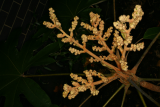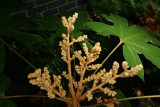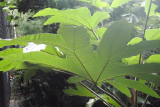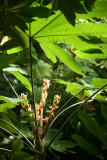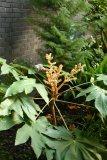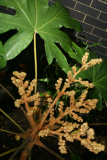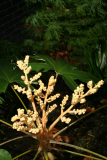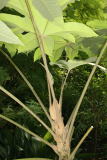Additional notes (click to expand)
Horticulture
A thicket forming, sparsely branched, evergreen shrub or small tree with stout shoots. The 5 to 11-lobed leaves, to 90cm (35in) across, scaly, mid-green above and felted pale green beneath, are clustered at the shoot tips. In winter the plant produces umbels, 1cm across, of white flowers in panicle-like inflorescences, to 50cm long, followed by spherical fruit, to 3mm across. It grows to 2.5m high by 2.5m wide.
Borderline frost hardy.
Brickell, C. (2003). A-Z Encyclopedia of Garden Plants. Dorling Kindersley. p.1029
Grow in any well-drained soil in full sun, sheltered from strong winds. In order to restrict the spread of established clumps, remove suckers at the extremities. Where top-growth is killed by frost, it maybe almost herbaceous, growing again from below ground. Prune in early spring, when dormant, removing misplaced or crossing shoots to maintain a permanent, healthy framework.
Brickell, C. (2003). A-Z Encyclopedia of Garden Plants. Dorling Kindersley. p.1029
To propagate, sow seed in containers in a cold frame in autumn. Remove suckers in spring or summer.
Brickell, C. (2003). A-Z Encyclopedia of Garden Plants. Dorling Kindersley. p.1029
Medicinal
Tetrapanax has been naturalised in China. Rice paper made from the pith is used for surgical dressings in China.
Knowles, J. (2009) Head Gardener, Royal College of Physicians
Nomenclature
Tetra’panax- Rice paper tree. Tetra is Greek for four. The flowers are in fours and have some resemblance to Panax. Araliaceae.
Stearn, W.T. (1996). Dictionary of Plant Names for Gardeners. Cassell. p.293
papy’rifer, paper-bearing.
Stearn, W.T. (1996). Dictionary of Plant Names for Gardeners. Cassell. p.230
Other use
The pith is an important source of fine rice-paper in China.
Mabberley, D.J. (1997) The Plant Book, ed.2, Cambridge University Press
This rice paper is used for toys, flowers, paintings and surgical dressings.
Knowles, J. (2009) Head Gardener, Royal College of Physicians
Toxicity
Handling this plant may cause skin irritation or allergic reaction. Pollen may cause an allergic reaction.
Geographical distribution
- Asia-Temperate, Eastern Asia, Japan
- Asia-Temperate, Eastern Asia, Taiwan
Tetrapanax papyrifer (Hook.) K. Koch 'Rex'
Family: ARALIACEAEGenus: Tetrapanax
Species: papyrifer (Hook.) K. Koch
Cultivar: 'Rex'
Common names: Chinese Rice-Paper Plant
Distribution summary: Japan, Taiwan
Habit: Shrub
Hardiness: H3 - Half hardy; unheated greenhouse/mild winter
Habitat: Thickets and open forest
Garden status: Not currently grown
Flowering months: November, December
Reason for growing: Other use, toxic

